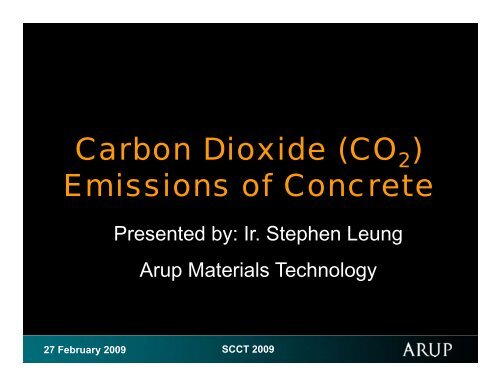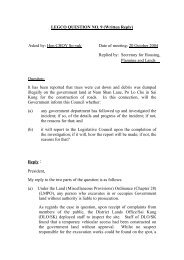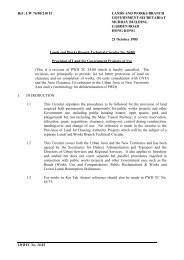Carbon Dioxide (CO ) Emissions of Concrete
Carbon Dioxide (CO ) Emissions of Concrete
Carbon Dioxide (CO ) Emissions of Concrete
Create successful ePaper yourself
Turn your PDF publications into a flip-book with our unique Google optimized e-Paper software.
<strong>Carbon</strong> <strong>Dioxide</strong> (<strong>CO</strong> 2)<br />
<strong>Emissions</strong> <strong>of</strong> <strong>Concrete</strong><br />
27 February 2009<br />
Presented by: Ir. Stephen Leung<br />
AArup Materials M t i l TTechnology h l<br />
SCCT 2009
Presentation Content<br />
• Gl Global b l Warming W i<br />
• Hong Kong Climate Changes and <strong>CO</strong>2 E<strong>Emissions</strong> i i<br />
• <strong>Carbon</strong> Footprint (t <strong>CO</strong>2) and Reducing<br />
C<strong>Carbon</strong> b EEmission i i<br />
• Embodied <strong>CO</strong>2 (e<strong>CO</strong>2) <strong>of</strong> Reinforced<br />
C<strong>Concrete</strong> t<br />
• Possible Alternatives<br />
• Challenges<br />
• Summary
Global Warming<br />
• Global Warming is caused by sharply<br />
increased greenhouse gases emission by<br />
human activities<br />
• In the building industry, carbon dioxide (<strong>CO</strong>2) emission mainly comes from cement<br />
production<br />
• It accounts for 2% - 3%<strong>of</strong> 3 % <strong>of</strong> human generated<br />
<strong>CO</strong>2 production and consumes about 0.5% <strong>of</strong><br />
total energy consumption.<br />
• <strong>Concrete</strong>, as a material, can never be truly<br />
sustainable, but we can reduce its impact on<br />
th the environment<br />
i t
Hong Kong Climate<br />
•The Hong Kong Observatory<br />
•No. <strong>of</strong> “cold days” are declining<br />
•No. <strong>of</strong> “hot nights” are increasing<br />
•Urban areas are warmer than the<br />
countries side by y 6°C in some <strong>of</strong> the late<br />
evenings
Hong Kong Climate<br />
•Tall buildings in Hong Kong are heated<br />
up dduring i the th day d and d release l thermal th l<br />
energy over night<br />
•Tall buildings also surround the inner<br />
city y and inhibit the cooling g effect <strong>of</strong> air<br />
circulation<br />
RESULTING HOT WEATHER!!
Hong Kong <strong>CO</strong> 2 <strong>Emissions</strong><br />
In Hong Kong, greenhouse gas emissions are<br />
approximately 6 tons <strong>CO</strong>2 equivalent per capita<br />
*Figure source from EPD
Hong Kong <strong>CO</strong> 2 <strong>Emissions</strong> (2)<br />
• <strong>CO</strong>2 emission per capita in Hong Kong is relatively low<br />
when compare to other international developed countries<br />
*Figure source from EPD
Hong Kong <strong>CO</strong> 2 <strong>Emissions</strong> (3)<br />
• The largest growth in <strong>CO</strong>2 emissions has come from power<br />
generation and road transportation<br />
*Figure source from EPD
<strong>Carbon</strong> FootPrint (t <strong>CO</strong> 2)<br />
•<strong>Carbon</strong> footprint is used to calculate<br />
th the amount t <strong>of</strong> f damaged d d caused d by b an<br />
individual, household, institution or<br />
bbusiness siness to the environment en ironment through thro gh<br />
harmful carbon dioxide emissions.
<strong>Carbon</strong> FootPrint (t <strong>CO</strong>2) –<br />
Reducing t<strong>CO</strong> 2 <strong>Emissions</strong><br />
•Reducing t<strong>CO</strong>2 emission is essential for<br />
sustainable t i bl environment i t<br />
•Can Can be achieved by:<br />
• Calculating the “carbon footprint” and identify routine <strong>of</strong><br />
most carbon consume activity. Where possible,<br />
minimize i i i th those activities. ti iti EE.g. WWalking lki or CCycling li<br />
instead <strong>of</strong> driving.<br />
• Reduce t<strong>CO</strong> 2 by y “Offsetting” g carbon emissions. E.g. g<br />
while continue to use current technology such as burn<br />
<strong>of</strong> fossil fuels, but may initiate to find overall reduction in<br />
emissions in the process to <strong>of</strong>fset the total emissions emissions.
Embodied <strong>CO</strong> 2 (e<strong>CO</strong> 2)<br />
•One way to measure carbon footprint in<br />
reinforced i f d concrete t is i by b unit it <strong>of</strong> f<br />
embodied <strong>CO</strong>2 (e<strong>CO</strong>2) •Definition:<br />
“Embodied <strong>CO</strong> 2 is defined as the <strong>CO</strong> 2 produced p over a<br />
defined part <strong>of</strong> the life cycle <strong>of</strong> the product. The <strong>CO</strong>2 is<br />
primarily associated with the consumption <strong>of</strong> energy<br />
over the relevant part <strong>of</strong> the life cycle cycle, but can also<br />
include emissions which occur directly as a result <strong>of</strong> the<br />
production process.”
So what does the e<strong>CO</strong> 2 have to<br />
2<br />
do with reinforced concrete?<br />
• Let’s take a look at some figures…<br />
e<strong>CO</strong>2 figures quoted from various sources
• More figures…
e<strong>CO</strong> 2 <strong>of</strong> reinforced concrete (1)<br />
2<br />
•When comparing e<strong>CO</strong>2 <strong>of</strong> concrete<br />
0.12t/t with cement 0.88t/t or with other<br />
building g materials (e.g. ( g steels) ) 0.82t/t,<br />
the e<strong>CO</strong>2 <strong>of</strong> concrete is relatively not<br />
that high. g
Sources <strong>of</strong> e<strong>CO</strong>2 for Reinforced<br />
<strong>Concrete</strong><br />
Co c ete<br />
Comes from:<br />
• Constituent materials<br />
• The fuel and process used to manufacture<br />
Portland Cement<br />
• The amount <strong>of</strong> Portland Cement replacement<br />
• The strength class <strong>of</strong> the concrete and the<br />
resulting mix composition<br />
• The level <strong>of</strong> steel reinforcement<br />
• Transports impacts <strong>of</strong> the aggregate and cement
e<strong>CO</strong> 2 from <strong>Concrete</strong> Constituents (1)<br />
Portland Cement<br />
• PPortland l d cement has h very high hi h embodied b di d <strong>CO</strong> 2<br />
content<br />
• Cement manufacture is energy intensive<br />
• Recent data on global <strong>CO</strong> 2 emissions from<br />
Recent data on global <strong>CO</strong> 2 emissions from<br />
cement manufacture give an overall average <strong>of</strong><br />
0.88 ton <strong>CO</strong> 2 per ton <strong>of</strong> cement produced. This<br />
figure includes all types <strong>of</strong> cement.
Cement Production Process<br />
Th The major j <strong>CO</strong> <strong>CO</strong>2 emissions i i arise i ffrom th three sources:<br />
*Figure source from www.lootahgroup.com<br />
• Combustion <strong>of</strong><br />
fuel to heat the<br />
kil kiln<br />
• Decarbonisation<br />
<strong>of</strong> limestone<br />
• Vehicle<br />
emissions during<br />
transport <strong>of</strong><br />
materials
e<strong>CO</strong> 2 from <strong>Concrete</strong> Constituents (2)<br />
Aggregates<br />
• AAggregates hhave a very low l embodied b di d <strong>CO</strong> 2<br />
compared to Portland cement and contribute<br />
only 3% to the total for reinforced concrete concrete.<br />
• Transportation <strong>of</strong> the aggregate to the batching<br />
plant l t and d to t site it accounts t for f most t <strong>CO</strong> 2<br />
emission.
e<strong>CO</strong> 2 from <strong>Concrete</strong> Constituents (3)<br />
Other major constituents<br />
Th <strong>CO</strong> fi d i b d f i<br />
• The e<strong>CO</strong> 2 figure presented is based on fair<br />
estimate in UK industry.
e<strong>CO</strong> 2 from <strong>Concrete</strong> Constituents (4)<br />
Secondary Cementitious Material<br />
• e<strong>CO</strong> 2 source data is available for Finland, UK<br />
e<strong>CO</strong> 2 source data is available for Finland, UK<br />
and US. Though there is variation between<br />
the source data, PFA and GGBS has<br />
significantly lower e<strong>CO</strong> 2 value than Portland<br />
Cement
e<strong>CO</strong>2 from <strong>Concrete</strong> Constituents (5)<br />
For a typical C32/40 mix<br />
Th <strong>CO</strong> i ib d b h f h<br />
• The e<strong>CO</strong> 2 is contributed by each <strong>of</strong> the concrete<br />
constituents is as follows:
Variations <strong>of</strong> e<strong>CO</strong>2 in <strong>Concrete</strong><br />
Strength and Mix Design<br />
• e<strong>CO</strong>2 also varies by strength class (i.e. the<br />
amount <strong>of</strong> cement content in the mix)
e<strong>CO</strong> 2 in Reinforcement<br />
•e<strong>CO</strong>2 varies only slightly with steel<br />
reinforcement<br />
•Reducing cement content will have<br />
greater effect than reducing the weight <strong>of</strong><br />
reinforcement
Level <strong>of</strong> Reinforcement with<br />
respect to e<strong>CO</strong> 2 levels
What to Do?<br />
Possible Alternatives<br />
1. Reduce <strong>CO</strong>2 emissions using other types<br />
<strong>of</strong> cement manufacturing g process<br />
2. Reduce Portland cement consumption<br />
33. RReduce d primary i aggregate t usage
Possible Alternatives 1<br />
Reduce educe <strong>CO</strong>2 <strong>CO</strong> <strong>Emissions</strong> ss o s through t oug<br />
Other Cement Manufacturing<br />
Examples <strong>of</strong> Possible Approaches –<br />
•Magnesium Magnesium Based Chemistry instead<br />
<strong>of</strong> Calcium Based Chemistry<br />
•Sample product includes:<br />
•CeramiCrete<br />
•EcoCement
CeramiCrete<br />
• Product developed by Argonne National Labs<br />
( (a US DDepartment t t <strong>of</strong> f EEnergy LLaboratory) b t )<br />
• Uses magnesium-based chemistry instead <strong>of</strong><br />
Portland cement’s calcium-based chemistry<br />
• Product formed by mixing magnesium oxide and<br />
soluble l bl phosphate h h t powder d with ith water t tto fform<br />
a<br />
phosphate ceramic (No <strong>CO</strong>2 producing<br />
carburization process involved)
CeramiCrete<br />
• Developed as a material for solidifying<br />
industrial waste<br />
• Used for repairing roads<br />
• EE.g. g Illinois Tollways and Chicago Skyway<br />
(US)<br />
• MMajor j drawback d b k ffor th the choosing h i this thi<br />
material for constructing the whole road is<br />
cost cost. It is 3 to 4 times more expensive than<br />
Portland cement.
CeramiCrete<br />
Ceramicrete concrete<br />
repair material intact and<br />
supporting vehicle traffic<br />
on surface road cracks<br />
*Figure source from www.anl.gov/techtransfer/Available_Technologies/Material_Science/Ceramicrete/Ceramicret_pothole.html
EcoCement<br />
• Product developed by TecEco (Australian research and<br />
development company)<br />
• Another magnesium-based material being marketed as<br />
an alternative<br />
• Made by blending reactive magnesium oxide<br />
(magnesia) with Portland cement.<br />
• Magnesia is ccurrently rrentl made from magnesite (Mg<strong>CO</strong> 3) )<br />
using energy to drive <strong>of</strong>f the <strong>CO</strong>2 from the carbonate<br />
(<strong>CO</strong>3). • Can be mixed with fly ash or ground granulated blast<br />
furnace slag<br />
• Offers better environmental credentials
EcoCement<br />
• Environmental claims:<br />
• Less energy is used to make magnesia than Portland cement<br />
• Wh When use as porous concrete t (e.g. ( concrete t pavements), t ) it<br />
can absorb <strong>CO</strong>2 from the atmosphere. (though this is also<br />
true for PC porous concrete due to process called<br />
carbonation!) b i !)<br />
• Major Drawback:<br />
• Th The environmental i t l impact i t and d availability il bilit <strong>of</strong> f extracting t ti<br />
magnesite from the ground not known<br />
• Magnesite g is not available gglobally, y source in China,<br />
impact <strong>of</strong> transportation<br />
• Limited applications for porous concrete<br />
• EcoCement is not readily available in commercial scale
Reduce Portland Cement Consumption<br />
EcoCement<br />
Note the <strong>CO</strong> 2 capturing during manufacturing can also be achieved if technology is available for Portland Cement <strong>Concrete</strong><br />
*Figure source from www.tececo.com/simple.eco-cement.php
Possible Alternatives 2<br />
Reduce Portland Cement<br />
Consumption<br />
•Secondary S d cementitious titi materials t i l<br />
• Ground granulated blast-furnace slag (GGBS)<br />
• PPulverized l i d fl fly ash h (PFA)<br />
Other Examples p <strong>of</strong> Possible Approaches<br />
pp<br />
•C-Fix<br />
•Air and foam-based concretes
Reduce Portland Cement Consumption<br />
Ground granulated g blast-furnace slag g<br />
(GGBS)<br />
•GGBS GGBS is generally used in proportions<br />
<strong>of</strong> 40-70% <strong>of</strong> the total cementitious<br />
materials content in structural concrete concrete,<br />
and up to 95% in specialist<br />
applications.<br />
•55% GGBS can reduce the embodied<br />
<strong>CO</strong> <strong>CO</strong>2 content <strong>of</strong> f a typical C C32/40 /<br />
concrete from approx. 115 kg <strong>CO</strong>2/ton to approx. 60 kkg <strong>CO</strong> <strong>CO</strong>2/ton. /
Reduce Portland Cement Consumption<br />
Ground granulated g blast-furnace slag g<br />
(GGBS)<br />
Major Drawback:<br />
• Sources <strong>of</strong> GGBS not readily available in<br />
Hong Kong. i.e. not economical to import blast<br />
furnace slag from steel mill.<br />
• Current specification not cater to adopt the use<br />
<strong>of</strong> blast furnace slag as substitution.<br />
• In UK current demand for ggbs exceeds its<br />
production by approx. 50%, i.e. needs<br />
importation (though by sea) and maybe not<br />
truly sustainable<br />
sustainable.
Reduce Portland Cement Consumption<br />
Pulverized Fly y Ash (PFA) ( )<br />
• Fly ash is generally used in proportions <strong>of</strong><br />
25 25-30% 30% <strong>of</strong> the total cementitious materials<br />
content in structural concrete<br />
• 30% fly ash can reduce the embodied <strong>CO</strong>2 content <strong>of</strong> a typical C32/40 concrete from<br />
approx approx. 115 kg <strong>CO</strong> <strong>CO</strong>2/ton /ton to approx approx. 85 kg<br />
<strong>CO</strong>2/ton. • SSources readily dil available il bl in i Hong H Kong.<br />
K
Reduce Portland Cement Consumption<br />
e<strong>CO</strong> 2 in GGBS & PFA<br />
2<br />
• For C32/40 concrete mix, reduction <strong>of</strong> e<strong>CO</strong> 2<br />
is shown through use <strong>of</strong> secondary<br />
cementitious materials.
Reduce Portland Cement Consumption<br />
e<strong>CO</strong> 2 in GGBS & PFA<br />
• More figures is shown in terms <strong>of</strong><br />
percentage p g saving g <strong>of</strong> e<strong>CO</strong> 2 through g use <strong>of</strong><br />
secondary cementitious materials.
Reduce Portland Cement Consumption<br />
C-Fix<br />
• Product developed by Shell and stands for<br />
carbon fixation.<br />
• A carbon-rich thermoplastic binder made from<br />
dense dense, carbon-rich residue left left over after crude<br />
oil has been refined.<br />
• Mixed using standard asphalt techniques at a<br />
temperature <strong>of</strong> about 200ºC.<br />
• AApplications li ti include i l d use in i breakwater b k t blocks, bl k<br />
modular road constructions, paving blocks,<br />
and liquid-tight, liquid tight acid acid-resistant resistant floor elements.<br />
elements
Reduce Portland Cement Consumption<br />
C-Fix<br />
• Use <strong>of</strong> one ton <strong>of</strong> C-Fix composite (binder + aggregate)<br />
fixes 150kg <strong>of</strong> <strong>CO</strong> 2. i.e. net saving to reduce 150kg <strong>of</strong> <strong>CO</strong> 2<br />
• Calculated by assuming 1 ton <strong>of</strong> composite contains 60kg <strong>of</strong><br />
carbon, which equates to 170kg <strong>of</strong> <strong>CO</strong> 2<br />
• Major drawback:<br />
• Limited use in structural applications where it is subject<br />
to pressure and high temperatures due to some degree<br />
<strong>of</strong> creep with time.<br />
• Product depends on crude oil processing i.e. extract,<br />
refine, fi and d burning b i products d t<br />
• Ideally if less crude oil is used, <strong>CO</strong>2 levels in the<br />
atmosphere p would be lower automatically y and no<br />
residue would be produced. i.e. No need for alternative
Reduce Portland Cement Consumption<br />
Air and Foam Based <strong>Concrete</strong><br />
• Foam-based concretes and Autoclaved aerated<br />
concrete (AAC) products (with up to 60-70% air content)<br />
• Provide suitable alternative material for low strength<br />
applications because they use less cement per cubic metre,<br />
and little or no aggregate. gg g<br />
• Australia’s CSIRO developed another aerated<br />
cementitious (cement-based) product, Hessle, that is as<br />
strong as normal concrete, is lightweight, and provides<br />
up to five times the thermal insulation properties <strong>of</strong><br />
concrete.<br />
• Reduces <strong>CO</strong> 2 emissions by increasing the energy efficiency <strong>of</strong><br />
the building and reducing the energy used during<br />
transportation and construction <strong>of</strong> the lightweight elements elements.
Reduce Portland Cement Consumption<br />
Air and Foam Based <strong>Concrete</strong><br />
•Major Drawbacks:<br />
• Foam-based Foam based concrete and AAC cannot<br />
replace normal structural concretes – only<br />
strengths <strong>of</strong> up to 15N/mm2 can be achieved.<br />
• AAC manufacture process requires high<br />
temperature and high pressure steam cure in<br />
an autoclave. t l<br />
• Energy (in terms <strong>of</strong> <strong>CO</strong>2 emissions) used to<br />
operate the autoclave has to be balanced<br />
against the savings made by reducing the<br />
cement content content.
Reduce Portland Cement Consumption<br />
Air and Foam Based <strong>Concrete</strong><br />
*Figures source from www.hyssil.com/technology.htm
Possible Alternatives 3<br />
Reduce Primary y Aggregate gg g Usage g<br />
• Recycled aggregate<br />
• Provisions included<br />
in BS 8500-2<br />
• Composition & use<br />
• Only coarse<br />
aggregate<br />
• High demand as fill<br />
and road base<br />
RRecycled l d aggregate stockpile<br />
k il
Challenges<br />
•The listed Portland cement substitutes<br />
products p are rather new, , largely g y<br />
unproven and not readily available<br />
•Portland P tl d cement t concretes t are cheap, h<br />
well established and readily-available<br />
materials materials, an any alternatives alternati es will ill have ha e to<br />
compete on costs and demonstrate<br />
advantage(s) over Portland Cement.<br />
Cement
Challenges<br />
•Lack <strong>of</strong> Material Specifications<br />
•Current exclusions (e.g. (e g GGBS)<br />
•Need some changes forthcoming<br />
•Recycled Aggregate supply<br />
•Location (transportation)<br />
•Continuity<br />
•Supplier Supplier reluctance<br />
•Cost
Summary 1<br />
•Global Warming is caused by the sharply<br />
increased greenhouse gases (GHG)<br />
emission by human activities with cement<br />
production accounting for 2% - 3% <strong>of</strong> <strong>CO</strong> 2<br />
emission or 0.88t <strong>CO</strong>2 per ton <strong>of</strong> cement<br />
produced.<br />
•The most significant GHG emitted in<br />
HHong Kong K iis carbon b di dioxide id and d<br />
significant source comes from electricity<br />
generation.<br />
ti
Summary 2<br />
•Transportation (in general) is the second<br />
largest source <strong>of</strong> <strong>CO</strong> 2 emissions in Hong<br />
Kong.<br />
•In the context <strong>of</strong> increased local<br />
environmental awareness, all industries<br />
have obligation <strong>of</strong> contributing towards<br />
alleviating global environmental<br />
problems<br />
Every Little Bit Helps!
Summary 3<br />
In Construction Industry<br />
•<strong>Concrete</strong> <strong>Concrete</strong>, as a material material, can never be<br />
truly sustainable, but there are things we<br />
can and should do to reduce its impact p<br />
on the environment<br />
•Search for alternatives to cement will<br />
undoubtedly grow as pressure increases<br />
to meet <strong>CO</strong> 2 emission targets.
Summary 4<br />
In Construction Industry<br />
•Portland Portland cement concretes are cheap cheap,<br />
well established and readily-available<br />
materials, , any y alternatives will have to<br />
compete on costs and need further<br />
researches.<br />
•Therefore, use <strong>of</strong> PFA or GGBS is<br />
recommended to be maximized
References<br />
1. A. Kendall. “<strong>Concrete</strong> Infrastructure Sustainability: Life Cycle Metrics, Materials Design, and<br />
Optimized Distribution <strong>of</strong> Cement Production” Report No. CSS07-07, May 2007. University <strong>of</strong><br />
Michigan, USA.<br />
2. Barker T., I. Bashmakov, L. Bernstein, J. E. Bogner, P. R. Bosch, R. Dave, O. R. Davidson, B. S.<br />
Fisher, , S. Gupta, p , K. Halsnes, , G.J. Heij, j, S. Kahn Ribeiro, , S. Kobayashi, y , M. D. Levine, , D. L. Martino, ,<br />
O. Masera, B. Metz, L. A. Meyer, G.-J. Nabuurs, A. Najam, N. Nakicenovic, H. -H. Rogner, J. Roy, J.<br />
Sathaye, R. Schock, P. Shukla, R. E. H. Sims, P. Smith, D. A. Tirpak, D. Urge-Vorsatz, D. Zhou,<br />
2007: “Technical Summary. In: Climate Change 2007: Mitigation. Contribution <strong>of</strong> Working Group III<br />
to the Fourth Assessment Report <strong>of</strong> the Intergovernmental Panel on Climate Change” [B. Metz, O.<br />
R. Davidson, P. R. Bosch, R. Dave, L. A. Meyer (eds)], Cambridge University Press, Cambridge,<br />
United Kingdom and New York, NY, USA.<br />
3. Environmental Resources Management. “Greenhouse Gase Emission Control Study: Revised<br />
Executive Summary”, Dec 2000. HKSAR Environmental Protection Department, Hong Kong.<br />
4. K.L. Chan. “Climate Issues in Hong Kong: Mitigation and Adaptation” Sep 2006. Yale University.<br />
5. K. Quillin. “Cements with Lower Environmental Impact” June 2008. BRE IP 7/08, Watford, UK.<br />
6. O. Poon. “Sustainable Development <strong>of</strong> Hong Kong” June 2007. Council for Sustainable<br />
Development, Hong Kong.<br />
7. http://www.anl.gov/techtransfer/Available_Technologies/Material_Science/Ceramicrete/index.html<br />
8. http://www.c-fix.com/english/default.htm<br />
99. htt http://www.epd.gov.hk/epd/english/environmentinhk/air/data/emission_inve.html<br />
// d hk/ d/ li h/ i ti hk/ i /d t / i i i ht l<br />
10. http://www.hyssil.com/technology.htm<br />
11. http://www.tececo.com/simple.eco-cement.php
Thank You<br />
Q&A Q & A







